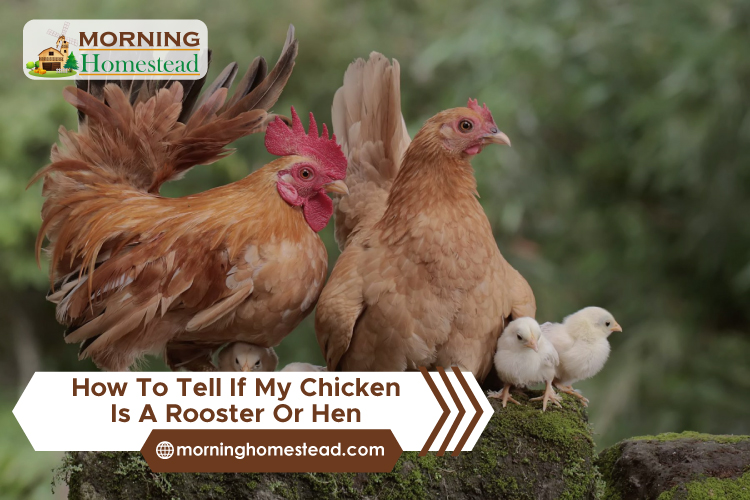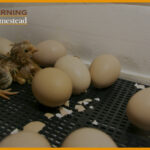Last Updated on June 7, 2023 by Georgie Smith
As a chicken farmer, you need to make sure that you have the right number of roosters and hens. If you have too many hens for one rooster, your eggs will not get fertilized. If there are too many roosters on your farm, the fights will be endless.
Many new farmers ask “How to Tell if my Chicken is a Rooster or Hen.” That is a fantastic question, and the answers are just as fascinating. The best way to ascertain your production is to be sure of how many roosters and hens are in the breeds you hatch.
In the past decade, there are numerous methods of ensuring that you can tell the sex of your chicks before they hatch or while they are chicks. Well, the probability is often 50-50. You may get 50-55 percent males and 50-55 percent hens from each batch of laid eggs.
These methods are reliable and will allow you to know your chances of getting fertilized eggs from your brood. These methods are excellent for farmers who buy chicks from other farmers. The last thing you want is to end up buying same-sex chickens and being confused about what to do when they are ready to mate.
The Egg
You can know the sex of your chicks right from the eggs. Most people assume that the round eggs produce hens while eggs with a sharp pointed tip indicate that it will hatch a rooster. Just to make things clear, the color of the eggs hatched has nothing to do with the sex of the chicks produced. Farmers who claim that they can tell the sex of a brood based on the color of the eggs are far from telling the truth.
Sometimes checking the tips has worked for most farmers. However, there are times when the eggs have a tiny tip that most farmers overlook. This method is therefore not as accurate as many would want it to be.
Vent Sexing
This method is also known as the Japanese sexing method. It started in the 1920s in Japan. Researchers found that there are characteristics like folds, spots, and lines that differentiate the two sexes. For the Japanese, this method requires Zen-like concentration and excellent manual dexterity.
Most vent sexers have to attend school for six months and a training program for two years. For every 2000 chicks vented, there is a 98 percent guaranteed accuracy.
In this method, the expert squeezes the chick to produce feces. This technique opens up the cloacae of the chick. It is known as the vent. Once open, the sexer can check whether there is a small bump in the vent. If it has a significantly large lump, then the chick is male.
They also check the genital organ that is midway to the rim of the vent. When the chick is young, the organ looks like a pimple. If the chick does not have this bump, it is female. Sometimes, the male will have a small pimple that is difficult to notice. It may, therefore, be noted as female while it is male.
At first, this method will be complicated, but with enough practice, you can be an expert at telling the sex of the chicks you buy.
Feather Sexing
You can tell the sex of the one-day-old birds by checking the feathers. Female chicks tend to have longer wing feathers than their male counterparts. In addition to having shorter feathers at the wings, roosters also have slightly longer butt feathers.
You can, therefore, tell whether a chick is female or male by looking at how long or short their feathers are, compared to other chicks in the brood.
Color Sexing
You can also tell the sex of the birds by checking the color of their parents. For instance, if silver-colored males breed with a golden-colored female, the chicks produced will display color variations that distinguish them. For example, the hens will have a darker; buff-down color while the males will have a white color.
If other colorations do not obscure the chicks, you will not need to be trained to find out their sexes. While this method is always accurate, it only works with farmers who know which hens’ eggs were used to hatch the chicks.
Auto-Sexed Breeds
Determining the sex of some chicken breeds is relatively easy and accurate. These breeds include New Hampshire, barred rocks, and Rhode Island Reds. In these breeds, the males have a large white head spot and yellow feet which are distinct.
Females, on the other hand, do not have a well-defined head spot and their feet have a darker color. These make it easier for farmers to pick enough chicks from the desired sex without worry.
Temperatures
According to scientists, the temperatures in the incubator can be used to determine the sex of the chicks hatched. For instance, if the temperatures have dropped to a few degrees in the embryological development of the eggs, the eggs will hatch out a male instead of a female chick. These chickens will have chromosomes and genes that are male, but they will have the productivity of females.
If these females get crossed with males, they end up producing more males than females. This technology is the same as that that is used to hatch broiler chicks. These breeds of chickens are stocked to have only male chicks. The temperatures have to be precise. It is the same technique used to make the right sex ratio for alligators and crocodiles.
Behavior
You can also notice the gender of the chicks if you look at their behavior. Right from the beginning, roosters tend to be bolder than hens. It is therefore essential that you note their reactions in the groups while you feed them. You can also check how they relate to each other.
Conclusion
If you are not sure about your ability to check the sex of the birds, you may call a venting expert who will check it for you. Learning the sexes will allow you to manage the broods and keep your eggs fertilized and minimize the fights from cockerels.
Hopefully after reading this when a new farmer asks you,” How to Tell if my Chicken is a Rooster or Hen,” you will have the best answers. Thank you for the time you devote to our site and reading our blogs. If you would, please share this on your social media networks to help us spread good knowledge on numerous topics. As always, we, appreciate you.





